| Article ID | Journal | Published Year | Pages | File Type |
|---|---|---|---|---|
| 8151 | Biomaterials | 2011 | 9 Pages |
Microelectrode electrophysiology has become a widespread technique for the extracellular recording of bioelectrical signals. To date, electrodes are made of metals or inorganic semiconductors, or hybrids thereof. We demonstrate that these traditional conductors can be completely substituted by highly flexible electroconductive polymers. Pursuing a two-level replica-forming strategy, conductive areas for electrodes, leads and contact pads are defined as microchannels in poly(dimethylsiloxane) (PDMS) as a plastic carrier and track insulation material. These channels are coated by films of organic conductors such as polystyrenesulfonate-doped poly(3,4-ethylenedioxy-thiophene) (PEDOT:PSS) or filled with a graphite-PDMS (gPDMS) composite, either alone or in combination. The bendable, somewhat stretchable, non-cytotoxic and biostable all-polymer microelectrode arrays (polyMEAs) with a thickness below 500 μm and up to 60 electrodes reliably capture action potentials (APs) and local field potentials (LFPs) from acute preparations of heart muscle cells and retinal whole mounts, in vivo epicortical and epidural recordings as well as during long-term in vitro recordings from cortico-hippocampal co-cultures.
